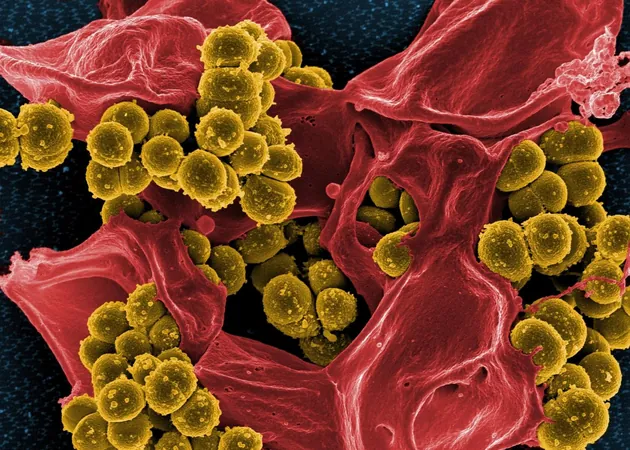
Breakthrough in Decoding MRSA Biofilm Sparks Hope Against Antibiotic Resistance
2024-10-24
Author: Siti
Introduction
Imagine a world where a seemingly simple infection could leave you fighting for your life. In today's medical landscape, the assurance that antibiotics will effectively treat ailments like pneumonia or blood poisoning is rapidly diminishing. The threat posed by Methicillin-resistant Staphylococcus aureus (MRSA) is escalating, and the World Health Organization (WHO) warns that millions of lives could be at stake without urgent solutions.
Understanding MRSA's Biofilm
MRSA is notorious for its ability to resist mainstream antibiotics, often due to its cunning adaptation—the formation of a biofilm made of proteins and sugars. This biofilm acts as a fortress, shielding bacteria from the very treatments intended to eradicate them. However, groundbreaking research conducted by scientists at Aarhus University and the University of Pittsburgh has made a shimmering breakthrough: they have decoded a crucial part of this biofilm structure, shedding light on a newfound approach in the battle against antibiotic resistance.
Expert Insights
Maria Andreasen, an Associate Professor at Aarhus University, elaborates on this significant advancement: “For the first time, we have detailed the molecular structure of a key element of S. aureus. This understanding of the biofilm's macrostructure opens doors to innovative strategies aimed at preventing its formation.” If successful, this could lead to groundbreaking treatment methods capable of dismantling MRSA's defenses.
The Stakes
The stakes are alarmingly high. A 2022 study reported that a staggering 1.27 million individuals succumbed globally to infections related to antibiotic-resistant bacteria in 2019 alone. Andreasen emphasizes, “These findings aren't just about cell structures—they represent a much broader public health threat. Identifying the full protein structure of MRSA biofilm empowers us to seek out molecules that could inhibit biofilm development, vastly improving treatment outcomes against these resilient pathogens.”
What Makes MRSA So Formidable?
MRSA, a strain of Staphylococcus aureus, has developed resistance to many commonly-used antibiotics, including methicillin and penicillin, which propels it into the category of superbugs. Here’s what you should know:
1. Ubiquity and Danger
While many harbor Staphylococcus aureus on their skin or noses without harm, this bacterium can unleash havoc if it breaches the body through cuts or abrasions, potentially leading to severe infections such as pneumonia or sepsis.
2. Resistance Challenges
The hallmark of MRSA—a formidable foe—is its resistance to standard antibiotic regimens. Such resistance complicates treatment and often necessitates the use of more powerful, less commonly employed antibiotics.
3. Hospital Settings
MRSA thrives particularly in healthcare facilities, where vulnerable patients with compromised immune systems are more likely to encounter this aggressive pathogen. The close quarters of hospitals and nursing homes facilitate rapid transmission among those who are most susceptible.
4. Consequential Health Risks
Infections caused by MRSA can escalate quickly, becoming life-threatening if not addressed promptly, especially if they invade the bloodstream or critical organs.
The Significance of the Current Research
The research team's pioneering work deciphers the molecular configuration of a vital aspect of the S. aureus biofilm, focusing specifically on the aggregated form of PSMα1, a functional amyloid recognized for its role in creating this protective barrier against antibiotic action.
What Lies Ahead?
This monumental discovery represents just the tip of the iceberg. While further investigation is necessary, the researchers' clarity on the molecular makeup signifies a major stride toward not only blocking biofilm formation but developing novel therapies capable of penetrating these protective shields.
Conclusion
As the world faces an increasing tide of antibiotic-resistant infections, this research offers a promising ray of hope. By understanding the defenses of MRSA, scientists may develop strategies that transform how we combat these formidable bacterial threats, paving the way for a future where even the most stubborn infections may be conquered. Stay tuned, as the battle against superbugs takes a pivotal turn!


 Brasil (PT)
Brasil (PT)
 Canada (EN)
Canada (EN)
 Chile (ES)
Chile (ES)
 España (ES)
España (ES)
 France (FR)
France (FR)
 Hong Kong (EN)
Hong Kong (EN)
 Italia (IT)
Italia (IT)
 日本 (JA)
日本 (JA)
 Magyarország (HU)
Magyarország (HU)
 Norge (NO)
Norge (NO)
 Polska (PL)
Polska (PL)
 Schweiz (DE)
Schweiz (DE)
 Singapore (EN)
Singapore (EN)
 Sverige (SV)
Sverige (SV)
 Suomi (FI)
Suomi (FI)
 Türkiye (TR)
Türkiye (TR)